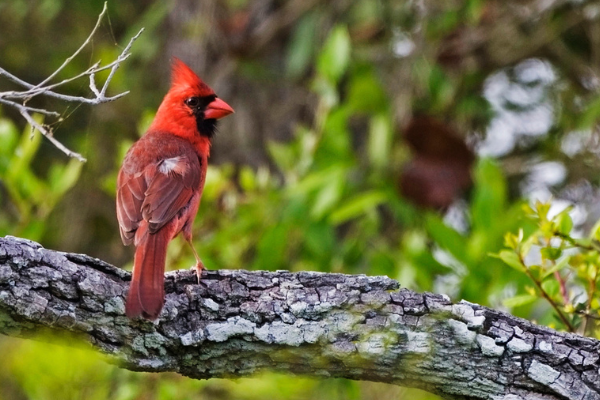Are you interested in finding the answer to do cardinals mate for life? I know it can be incredibly frustrating not knowing the answer to pressing questions. But there is nothing to worry about because I’m about to provide the answer you seek and so much more below.
Cardinals are a monogamous species. They mate for life. The male cardinal helps the female cardinal build a shallow-cupped nest. It takes 3-9 days to finish building the nest. The happy couple builds their nest with strips of bark, leaves, grass, small twigs, and animal hair by weaving them together.
I know how difficult it is to find information about cardinals regarding their mating habits. You often wonder if they mate for life, fall in love, or remain together after they have hatchlings and other important topics.
Today, I’d like to share as much information about meetings, motherhood, fatherhood, and other important information about their habits and rituals. Continue reading to learn more about this interesting and important topic.
The Absolute Truth About Monogamy Among Cardinals: A Love Story For The Ages
Looking out your window into your backyard, you see two gorgeous cardinals sitting together at the top of your fence. It’s obvious that one cardinal is male and the other is female. The male Northern cardinal has brilliant red feathers that covered his entire body and a black face and reddish bill. The female is covered in brown feathers with warm reddish tinges across the chest, tail, and wings. She also has a red bill and black face, just like her male counterpart.
You have to wonder, “Are these two beautiful birds in love?” Or, is it possible that they mate briefly and move on after their time together is done? Have you guessed, “Do cardinals mate for life?”
According to Penn State University, “Cardinals are predominantly monogamous and will mate for life.” It’s beautiful to learn that these wonderful birds will attempt to stay together in their natural forest habitats in the Eastern United States for as long as possible. One would have to imagine that they grow to love each other if they’re willing to stay together for as long as they live.
In a world where so many things seem to go wrong so often, it’s nice knowing that cardinals are looking for their one true love. And they are willing to spend the rest of their lives together mating and having babies and doing all of the fun and exciting things that cardinals do!
Have You Ever Wondered What Colors Attract Cardinals To A Backyard?
We Conducted Multiple Hours Of Research To Figure Out What Colors Attract Cardinals To A Backyard. Click The Button Below to Learn More!
What Colors Attract Cardinals to A Backyard?Tragedy Strikes: What Happens When A Cardinal Loses Its Mate?
While we have answered “Do cardinals mate for life?”, it’s sad to think about cardinals losing their mates, just like any other species, it certainly happens from time to time.
You might be wondering what happens after a cardinal’s lifelong mate is no longer with them because they split up or one of the partners passed away.
It’s rare, but sometimes cardinals do break up. And when this happens, they will not remain alone for very long. In fact, if nesting season is taking place, you will quickly see the cardinal connect with a new mate.
The same holds true after one of the cardinals dies. They do not wait very long to find a new mate. In fact, instead of going through a tremendous amount of pain and suffering because of the death, they actually find another mate very fast after their previous mate dies.
I know it’s nice to believe that cardinals will remain together forever and have a beautiful monogamous love story. While this is certainly the case for many cardinals, it’s also instinctual to find another mate as soon as their previous mate breaks up with them or passes away.
It’s also important to know that at other times, cardinal pairs will split up and go their separate ways. They will join the winter flock together and become a part of the group instead of remaining together in their nesting place as a pair.
Related article: An In-Depth View Of Where Do Cardinals Nest?
Nesting 101: Will The Same Pair Of Cardinals Return To The Same Nesting Area The Following Spring?
Here’s an interesting fact about cardinals:
They will never under any circumstances reuse the same best that they previously used for their hatchlings. But it’s more than possible for cardinals to return to the same nesting place if they happen to prefer the area.
What would make cardinals prefer a particular nesting place?
For starters, they may want to come here if the conditions are favorable. There may be plenty of foliage around for them to use for food or to use to make their nest. There may be lots of water in a particular nesting place that would draw cardinals back to the area because having a fresh source of water is important during nesting time.
Lastly, a particular area mate is a great place to build a nest because there are plenty of food sources available to the cardinals during their nesting time. According to Pennsylvania State University, “Cardinals have long breeding seasons from late March to early September. They lay eggs twice a year during these spring and summer months. In some southern states, cardinals may even have three broods in a year.”
Clearly, due to the long mating season, it makes sense that cardinals would come back to a favorable location with great conditions during nesting season. The cardinals will return as a pair because of the favorable experience they previously had in this location.
Family Affair: Do Cardinals Stay Together As A Family?
This may come as a surprise to some of you, but some pairs of cardinals will remain together in their nesting territory all year long. The female and male partner remains with their hatchlings to feed and nurture them and help them grow. They also stay together to create new hatchlings and continue the cycle of life.
According to Birdfeeder Hub, “Both the female and male will work together during mating season to build their nest together, which takes about 8-9 days.”
The story gets even more interesting because after the babies are born, the father and mother will often work together to feed and care for the younglings. The male cardinal will gather food for the young birds and the female will remain in the nest with her hatchlings to keep them fed, warm, and comfortable as they continue to grow at the beginning of their life.
Typically, cardinals are known for making their nests out of plant materials including grass, twigs, and other plant life. They like building their nests in the trees, shrubbery, or bushes. More often than not, they do not like to have their nest higher than 10 feet above the ground. In fact, they prefer to keep their nest lower than 10 feet off the ground to keep their young ones safe and protected in case they were to accidentally fall out of the nest.
More often than not, you’ll discover cardinal nests on low branches, within dense shrubbery, or inside of bushes. These are the ideal nesting places for cardinals when they are waiting for their baby birds to hatch during nesting season.
Mates For Life: A List Of Birds That Remain Monogamous Throughout Their Lifetime
It shouldn’t surprise anyone to learn that cardinals aren’t the only birds to mate for life. Other bird species find a mate and stay together until one partner eventually dies and passes on from this life.
A list of other monogamous birds that mate for life includes:
- Black Vultures
- California Condors
- Swans
- Bald Eagles
- Whooping Cranes
- Lovebirds
- Monk Parakeets
- Atlantic Puffins
- Northern Cardinals
- Scarlet Macaws
- Pigeons
- Barn Owls
- Sandhill Cranes
- Geese
- Albatrosses
- Macaroni Penguins
Each one of these bird species prefers monogamy as their best strategy for reproduction. In fact, the World Wildlife Foundation claims that “90% of [bird] species choose monogamy as their reproductive strategy. This is a huge number compared to mammals at just 5%.”

Fatherly Love: Are Male Cardinals Considered Devoted Fathers?
Since mammals tend to mate and then go their separate ways, most people believe that cardinals and other birds follow the same pattern. But in the case of mail Cardinals, nothing could be further from the truth.
Male cardinals really seem to love and care for their young fledglings. According to a wonderful story shared in The Atlanta Journal-Constitution while bird watching, “A brilliant red male cardinal was gently feeding two of his wobbly fledglings as they perched on a dogwood tree limb. The dad would hop down to a suet feeder, pack off a piece of the food, and then fly back to his babies and feed it to them.”
After reading the rest of the story, it says the father continued to feed the young cardinals sunflower seeds for several minutes until they were full and satisfied. Afterward, the young children were spotted disappearing into the nearby shrubs with their loving dad.
This is a touching story and a beautiful scene, to say the least. And it teaches us those male cardinals are devoted to their young and really care for their children after they enter the world. The male cardinal also plays a key role in building the nest, feeding and protecting the young, and much more than simply fertilizing eggs for their females.
The Final Word On Do Cardinals Mate For Life
People want to believe in fairytales. But more often than not, they are usually disappointed when things don’t seem to go the way they desire.
Most people are absolutely ecstatic when they finally hear that cardinals mate for life. They think that like most mammals, cardinals will meet and then move on. But monogamy is part of their mating ritual and the best way to keep their species alive and kicking.
Right now, I’d like to give you a refresher on all of the information shared with you today. This will help you better understand cardinals and their mating habits, their nesting habits, how male cardinals interact with their fledglings, and much more.
The most important points to remember are as follows:
- Male and female cardinals mate for life. For the most part, they remain monogamous with their chosen partner. Occasionally, cardinals will split up and find other mates.
- When cardinals die, their mate will quickly and immediately find another partner, which is especially true during nesting season.
- Cardinals often return to the same nesting space while mating. They do when they find a fertile area with plenty of water, food, and foliage to keep them safe and protected.
- Cardinals also remain together as a family. The male cardinal will help the female build the nest and gather all the supplies to create it. They will also find food and water for their fledglings. Females will remain in the nest with their younglings to keep them safe, protected, and warm.
- Male cardinals are devoted to their children. They will feed them, shelter them, provide water for them, and keep them protected from predators and other beings that would potentially do them harm.
Thanks for taking the time to read this important information about cardinals and whether or not they mate for life. I hope you found this information useful and informative. Feel free to leave a comment below with your thoughts, questions, or additional information that would add value to this document about mating cardinals.

from BirdInformer.com https://ift.tt/TSVokhz

No comments:
Post a Comment